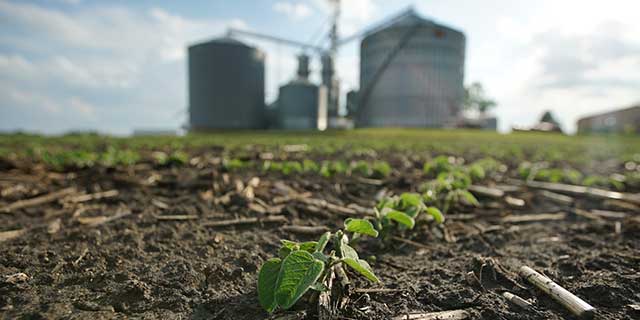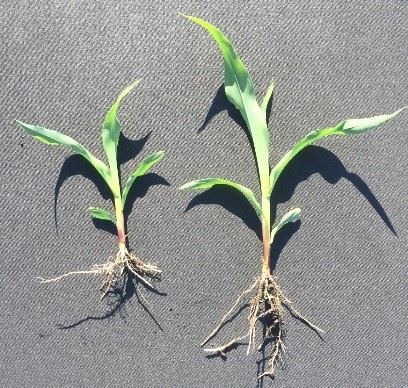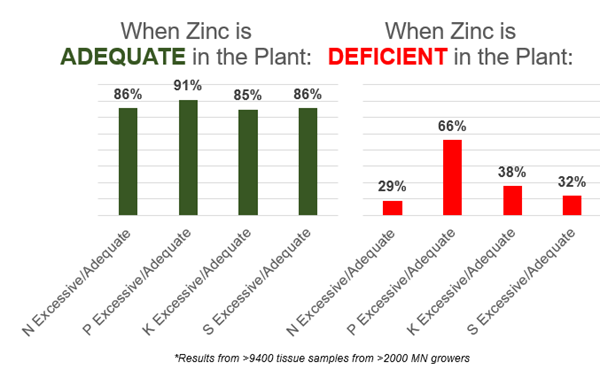Growing Insights
Jun 03, 2020

Conditions UpdateCrop progress across MN from the week June 1st, 2020 has corn conditions at 22% excellent, 61% good, 15% fair, and 2 % poor/very poor. Soybean conditions are at 19% excellent, 65% good, 15% fair, and 1% poor/very poor. The first week of June is ushering warm temperatures and scattered storm risks across the area. Average temperatures for this time of the year are still in the mid 70’s, so the high 80’s forecasted for the next week will definitely reduce the small amount of GDU’s that the area is behind dating back to April 20th. Remember, corn growing degree units (GDU) are calculated by subtracting the plant's lower threshold temperature of (50 °F) from the average daily air temperature in °F. Average daily air temperature is calculated by averaging the daily maximum and minimum air temperatures measured in any 24-hour period, but the daily maximum temperature cannot exceed 86 °F. The rate of growth for corn does not increase with increasing temperature above 86° F, so the forecasted high temperatures will be pushing the corn crop along as fast as it can! |
|---|
Corn Growth and Development

As corn continues to rapidly grow through vegetative stages, it’s starting to uncover some variability in crop growth. Whether it’s differences in color or growth stage, the above-ground portion of the plant might not tell the whole story of what the corn plant is experiencing, especially with some of the compaction from planting that roots are encountering. The picture shows a common trend in many local fields, with 2 plants in close proximity both at the same growth stage, but major differences in height and root growth. As V5 approaches and corn starts the determination process of kernel rows per ear, it’s critical to understand what may be limiting crop growth. Tissue sampling offers insight into a crop’s potential “hidden hunger.” Plant tissue samples help to understand how well your crop is taking up nutrients given the conditions we’ve had this year.
History shows that a known limiting factor, zinc, could also be a key yield factor this year. The image below outlines the number of tissue samples taken in southern MN that have shown responsiveness or deficiency to zinc between V5-V10. The 5-year average for CFS shows that 88% of tissue samples taken around V4-V8 show zinc as a potential limiting factor. Zinc plays a critical role in maximizing leaf and vascular growth and root development. A larger, more robust root system allows for increased nutrient uptake and more efficient water use. Zinc is also immobile in the soil and requires the roots to find concentrations of zinc in the soil to be taken up. Historical data shows that zinc deficiencies start around the V4-V5 growth stage. Prior to V4-V5, the tissue samples often show zinc at adequate levels as the first 4 true leaves are already formed in the seed embryo, so applying zinc in starter fertilizer or using Croplan seed with a zinc seed treatment often fulfills the early zinc needs.
Manganese and Boron are also critical micronutrients to focus on. Manganese is an essential micronutrient for photosynthesis. The corn plant maximizes photosynthesis from V9 to V15, making it an ideal time for a manganese application. Manganese is typically tied up in the soil, so one of the best ways to get it into the plant is via a foliar application. Boron is also important as one of its jobs is to help transfer carbohydrates in the plant. Especially later in the year, around tassel time, a plant’s stalks and leaves lose boron as it is remobilized to the ear silk and to the tassel; this means that plants may not be able to transfer carbohydrates effectively to the newly developing kernels as efficiently ahead of pollination. When it comes to micronutrients products, there are many different options and formulations. Some formulations are more efficient for plant uptake than others. A micronutrient option such as MAX-IN® Zinc with CornSorb® technology is a foliar option that increases droplet spread, droplet coverage and humectancy for increased movement of nutrients through the leaf cuticle to internal leaf structures. That means more zinc gets into the plant.
Contact your CFS representative if you’d like to take tissue samples on your fields.

Early Season Corn Management Decisions
If you are deficient in zinc, you can consider applying a foliar micronutrient. At CFS, we rely on two different products, Max-In Ultra ZMB, and Max-In Zinc. Both of these products contain CornSorb® technology to greatly increase the movement of micronutrients through the leaf cuticle and less zinc subject to loss through evaporation and other environmental forces. Max-In Ultra ZMB is a foliar micronutrient and combines zinc, manganese, and boron into one product. Max-In Zinc is a zinc-only foliar product option.- WinField United AnswerPlot data shows that 1 quart/acre of Max-In Zinc applied at V5 is responsive 55.6% of the time, and equivalent to 6 bpa increase in yield.

Another foliar application consideration to enhance root growth is a plant growth regulator. PGRs are hormones that regulate the growth and development of plants. There are five basic classes of plant growth regulators. Each of these has a different effect on plants, ranging from stimulating plant growth to dictating seed germination. Plant responses may vary depending on PGR type, rate and application timing. Ascend® SL plant growth regulator by WinField United contains three EPA-registered active ingredients to promote cell division, leaf expansion, and stimulate root formation.
A V5 application of fungicide may also be an important agronomic consideration this year. Normally at tassel, we would use the individual hybrid response to fungicide scores to understand the likelihood of a positive response to fungicide, but V5 application should be made based on plant observations. If you notice brown discoloration starting on the corn’s mesocotyl or crown region, a V5 fungicide application can be used to manage potential seedling diseases.
